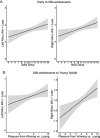Contributions of Reward Sensitivity to Ventral Striatum Activity Across Adolescence and Early Adulthood
- PMID: 29536503
- PMCID: PMC5969258
- DOI: 10.1111/cdev.13056
Contributions of Reward Sensitivity to Ventral Striatum Activity Across Adolescence and Early Adulthood
Abstract
It was examined how ventral striatum responses to rewards develop across adolescence and early adulthood and how individual differences in state- and trait-level reward sensitivity are related to these changes. Participants (aged 8-29 years) were tested across three waves separated by 2 years (693 functional MRI scans) in an accelerated longitudinal design. The results confirmed an adolescent peak in reward-related ventral striatum, specifically nucleus accumbens, activity. In early to mid-adolescence, increases in reward activation were related to trait-level reward drive. In mid-adolescence to early adulthood decreases in reward activation were related to decreases in state-level hedonic reward pleasure. This study demonstrates that state- and trait-level reward sensitivity account for reward-related ventral striatum activity in different phases of adolescence and early adulthood.
© 2018 The Authors. Child Development published by Wiley Periodicals, Inc. on behalf of Society for Research in Child Development.
Figures


References
-
- Abler, B. , Walter, H. , Erk, S. , Kammerer, H. , & Spitzer, M. (2006). Prediction error as a linear function of reward probability is coded in human nucleus accumbens. NeuroImage, 31, 790–795. https://doi.org/10.1016/j.neuroimage.2006.01.001 - DOI - PubMed
-
- Akaike, H. (1974). A new look at the statistical model identification. IEEE Transactions on Automatic Control, 19, 716–723. https://doi.org/10.1109/TAC.1974.1100705 - DOI
-
- Bhanji, J. P. , & Delgado, M. R. (2014). The social brain and reward: Social information processing in the human striatum. Wiley Interdisciplinary Reviews. Cognitive Science, 5(1), 61–73. https://doi.org/10.1002/wcs.1266 - DOI - PMC - PubMed
-
- Braams, B. R. , Güroğlu, B. , De Water, E. , Meuwese, R. , Koolschijn, P. C. , Peper, J. S. , & Crone, E. A. (2014). Reward‐related neural responses are dependent on the beneficiary. Social Cognitive and Affective Neuroscience, 9, 1030–1037. https://doi.org/10.1093/scan/nst077 - DOI - PMC - PubMed
-
- Braams, B. R. , Peters, S. , Peper, J. S. , Güroğlu, B. , & Crone, E. A. (2014). Gambling for self, friends, and antagonists: Differential contributions of affective and social brain regions on adolescent reward processing. NeuroImage, 100, 281–289. https://doi.org/10.1016/j.neuroimage.2014.06.020 - DOI - PubMed
Publication types
MeSH terms
LinkOut - more resources
Full Text Sources
Other Literature Sources

